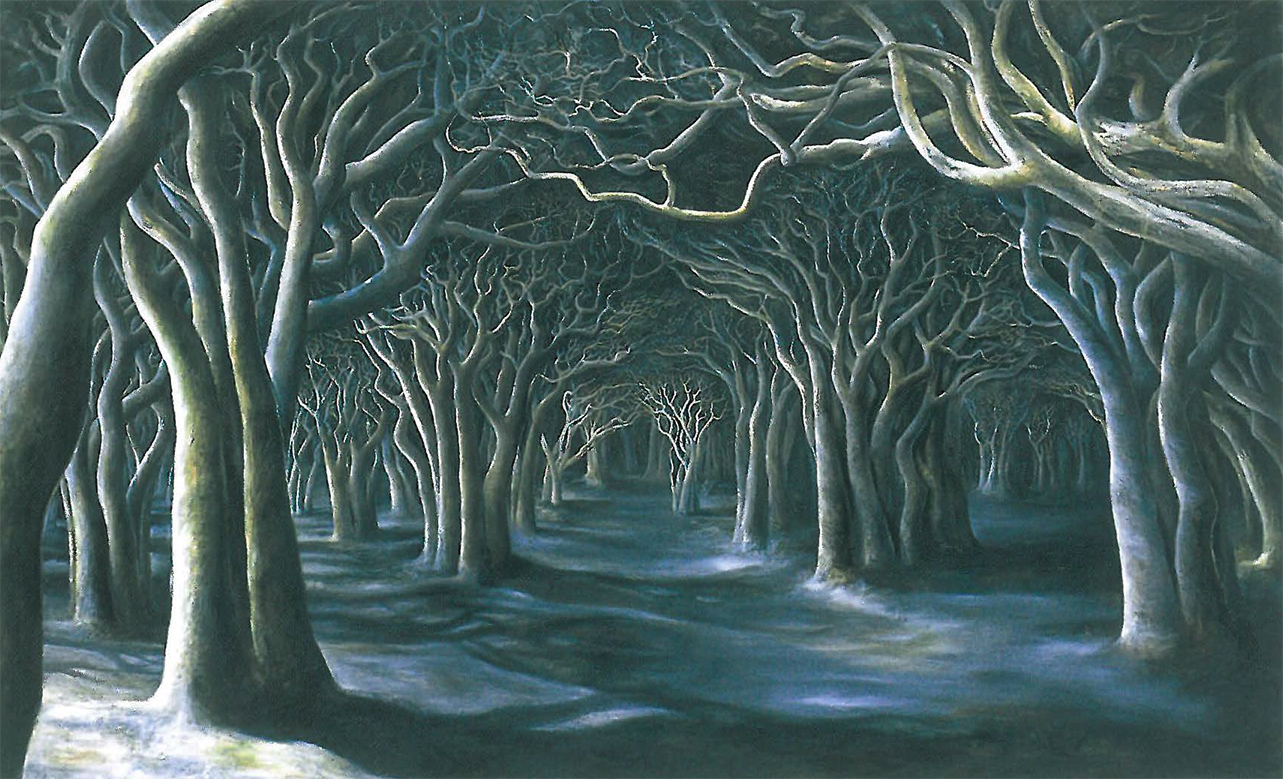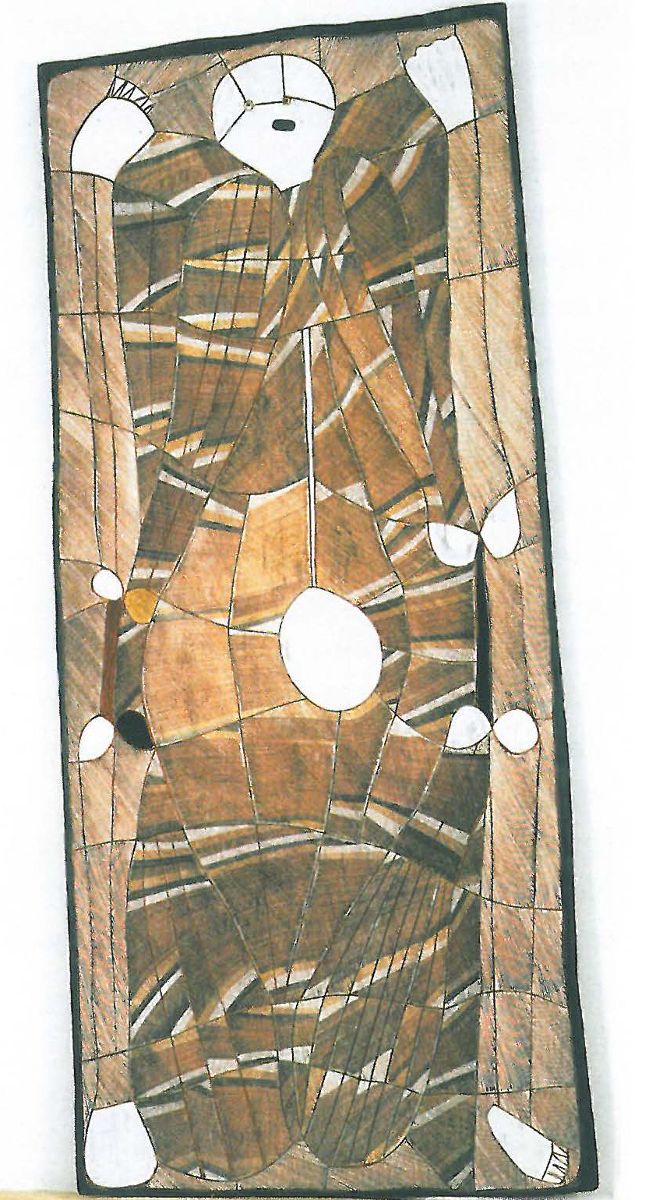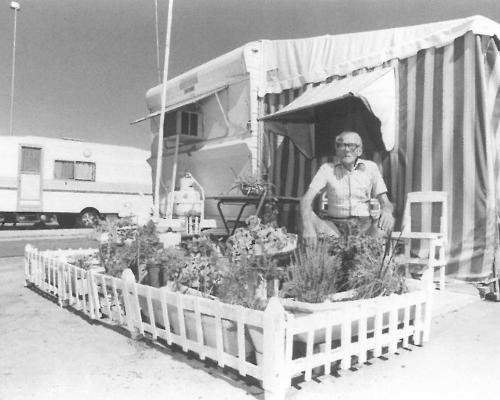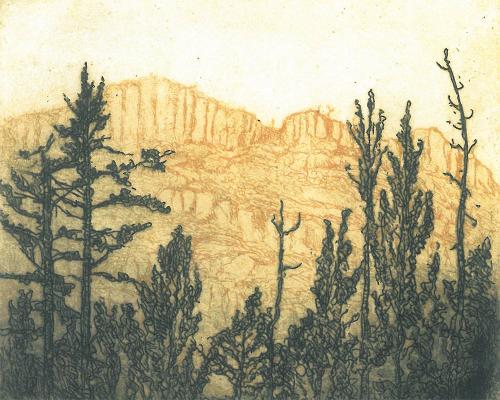
The overall winner of this year's NATSIA award is Arnhem Land-based artist and ordained Uniting Church minister Gawarrin Gumana for his 3 metre high hollow log Birrkuda Rinngtj. This is the first year in the award's history that a three dimensional object has won the coveted $40,000.00 first prize, and Birrkuda Rinngtj deserves both the award and the accolades that come with it.
Gawarrin Gumana's work is a fine example of a hollow log coffin. It stands in a group of other expertly crafted poles from the same region. These works collectively comprise what seems to be the epicentre or focal point of the exhibition.
Certain individuals and/or clan groups 'own' or have proprietal rights over the specific crosshatching patterns adorning these hollow logs – somewhat akin to the Scottish tartans where particular designs are emblematic of clan ownership. Initially the logs are hollowed out by natural means, by termites tunnelling through tree trunks, after which the poles are painted with the appropriate clan design. Gawarrin Gumana's personal visual identity-marker is a finely wrought diamond-shaped Yirritja moiety honey design, beautifully rendered in natural pigments. Birrkuda Rinngtj is a triumph both in terms of its overall composition and in its attention to the minutiae of the design elements. In a wonderful 'finishing' touch the artist has left an unadorned ring of bark at the top of his log. The raw timber on display atop the sculpture serves to re-connect the work, quite literally, to its roots in the natural world.

The judges of this year's Telstra award, Judith Ryan and Brook Andrew, have been criticized in the national media for drawing attention to the broader political connotations of Gawarrin Gumana's work, rather than basing their decision exclusively on so-called "aesthetic" criteria. The irony is of course that 'judging the judges' in this manner itself involves taking a particular type of political stand. And in the case of Birrkuda Rinngtj, a persuasive case can be made for the inseparability of the object's function and the ideology of its aesthetic. This means that placing the work in its broader social context becomes not only justifiable but also obligatory.
In the past the bones of the person who had passed away would be placed inside these decorated vertical freestanding coffins, as part of funeral rites or 'sorry business' within a broader ceremonial context. It is however true that today these memorial poles are often created as objects of beauty in their own right and sold to collectors of fine art.
Notwithstanding, hollow logs continue to be used for their original purpose in mortuary rites throughout parts of Arnhem Land. They therefore need to be understood, like other artistic practice, as existing within a particular art-historical context and as framed within their own distinctive historical trajectory, despite the fact that they now also exist within the context of international commodity capitalism. So while some people now regard them simply as objets d'art, they are still memento mori. Strong connotations of death, grief and mourning continue to surround and infuse these remarkable sculptures. Sombre and elegant, beautifully painted with his inherited imagery, Gumana's hollow log coffin sculpture not only satisfies the aesthetic criteria of the dominant culture but also speaks eloquently to that earlier history. Birrkuda Rinngtj accrues a further layer of meaning that comes with the realization that Gumana is now the sole surviving member of his clan group with the right to reproduce this special clan imagery. Others in Gumana's patriline were murdered in a massacre several generations ago. Insisting that such an artwork be appreciated outside of such an historical context is, in my view, a risky business.
The three dimensional objects in this year's exhibition are, on the whole, very strong. Other 3-D works worthy of mention include a wonderful installation of Tunga (stringy bark baskets decorated with natural ochres and used for collecting food as well as in mortuary rites) by a group of Tiwi Islanders Mary Magdalene, Maryanne Mungatopi and Leon Puruntameri. Other examples are two large figurative carvings by Kunwinjku countrymen Owen Yalandja and Crusoe Kurddal. Yalandja's Yawk Yawk maiden, a kind of Antipodean mermaid with attitude, and Kurddal's Mimi Spirit, a tall thin 'good' spirit whose body has a large and apparently malevolent snake wrapped around it, are works of integrity and considerable visual power, evincing technical prowess with the medium.
This year's $4,000.00 General Painting Award goes to Perth artist Christopher Pease for his oil on canvas Wadatji Country – Belief and Disbelief. Pease has created an enchanted spirit-filled forest of knotty tree trunks and coiling, intertwining boughs and branches, characterized by strong vertical lines. The simultaneously animate yet strangely artificial nature of the leafless trees which are arranged rather like a hall of mirrors, and Pease's effective deployment of a gloomy, limited palette brings a sinister, mind-altering dimension to the work. The branches of these strangely anthropomorphized trees give the impression that they could lean out and grab you. The sense that Pease engenders in the viewer – that one could possibly disappear into his painting – is somewhat disconcerting. Enid Blyton meets Timothy O'Leary? Lin Onus on mescalin? Perhaps. Yet such comparison is unfair, for here is an artist who is already well on the road to establishing his own unique voice, and whose future career will be well worth following.

Established bark painter, John Mawurndjul, whose work was among those chosen for the celebrated Magiciens de la Terre exhibition for the French Bicentenary of 1989, has won this year's $4,000 Bark Painting Award for his Buluwana. This is an arresting, even confronting image of an Ancestral Woman of the same name, who was turned into rock during the Dreaming as the result of an encounter with a malevolent Deaf Adder.
The highly acclaimed Tiwi artist and living national treasure Kitty Kantilla is the deserving recipient of the $4,000 Telstra Work on Paper Award for her understated traditional geometric design using ochres entitled Pumpuni Jilamara. The artist, one of the original Paru women artists' colony which began three decades ago, shows that as she enters her seventh decade she is still going strong.
This year's $4,000 Wandjuk Marika 3D Memorial Award goes to Arrernte artist Carol Panangka Rontji for her charming hand-modelled terracotta with underglaze and glazes, Eeranda Pmara Nukanala, Black Cockatoos in My Country.
There are four Highly Commended artists this year: Darren Siwes and Jennifer Jundruwanda who are both Adelaide and Taoundi College-based; Naata Nungurrayi for her fabulous abstract Women at Marrapinti depicting country and woman-power; and finally, Top Ender Timothy Wulunjbirr for his bark painting Ngalyod, Rainbow Serpent.
It does also need to be stated that there are a number of very ordinary works in this year's Telstra, including several by artists who are among the top ranking in the country.
Equally, there are some works that did not win awards but which really stand out. These include Barney Ellaga's wonderful Minyerri Country, Dumyungangaya, Andrea Nungarrayi Martin's tight, elegant and beautifully controlled composition Janganpa and Jajirdi Jukurrpa, Possum and Native Cat. Judy Baypungala has woven a huge and fabulous pandanus mat (simply called Pandanus Mat). Richard Bell's all-Black Colin McCahon-influenced painting I Am Not Sorry is a very strong work that really packs a political punch. Youthful Charlene Carrington from the Kimberley region has created an interestingly hybrid work in Rover, Queenie, George - My Three Teachers. While it doesn't quite come off it is an ambitious work underpinned by an intelligent approach that could potentially lead the artist in an exciting new direction.
This year's works will form the basis of the NATSIAA touring exhibition for 2004, so if you missed it in Darwin there is ample opportunity for engagement, further down the track, with many of the works in this popular and successful exhibition.












